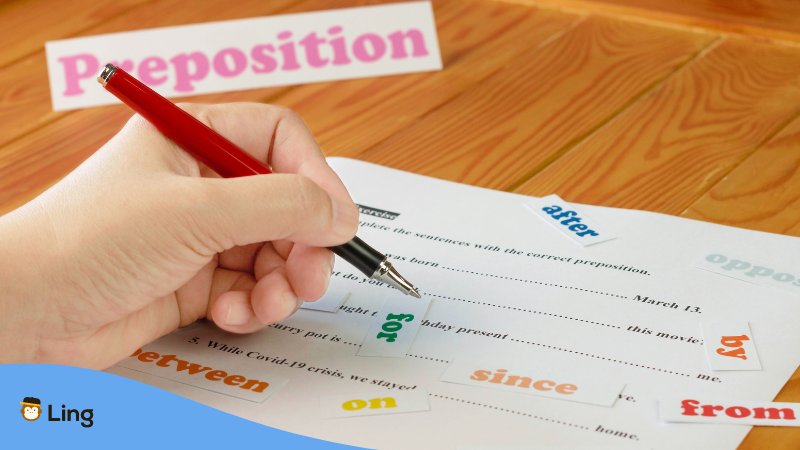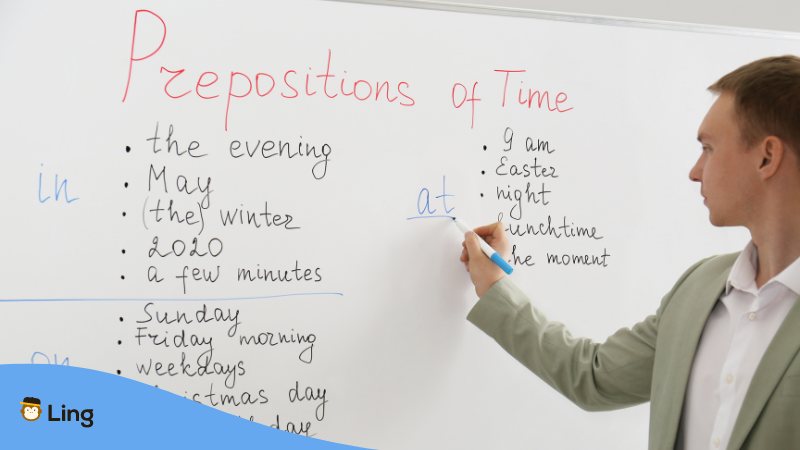Have you ever wondered how Cantonese speakers put together such intricate sentences? Well, prepositions play a crucial role in the Cantonese language, helping to convey the relationships between different elements in a sentence.
In this article, we’ll explore Cantonese prepositions in-depth, discussing their various types, common usage, and useful vocabularies for you to sound even more fluent.
By the end, you’ll be able to confidently incorporate prepositions into your Cantonese conversations and improve your overall language skills. So, let’s study Cantonese right now!
What Exactly Are Prepositions?
For starters, Cantonese prepositions are kind of like little helpers that link Cantonese words in a sentence. They tell us how different things are related to each other.
So if we say, “I’m walking to the store,” the preposition “to” tells us the direction of where we’re walking.
In Cantonese, we have some common prepositions like “喺” (hai2 – at/in/on), “比” (bei2 – than/to), “從” (cung4 – from/since), and “向” (hoeng3 – towards/to).
These can help us give more details about position, direction, time, and comparisons.
Are Prepositions The Same As Demonstrative Pronouns?
Most people, especially non-native Cantonese speakers, commonly mistake prepositions for demonstrative pronouns. So, are they the same? Well, the short answer is “No.”
The long answer is that demonstrative pronouns are like little pointers in a sentence. They help us identify specific things.
In Cantonese, we have three main demonstrative pronouns: “呢” (ni1 – this), “嗰” (go2 – that), and “嗰啲” (go2 di1 – those).
“呢” is used when we want to point out something close to us. While “嗰” is used when we want to point out something close to “you.”
Lastly, “嗰啲” is used when we want to point out something far away from us.
Even though prepositions and demonstrative pronouns give us more details about a noun in a sentence, they have different jobs.
To clarify, Cantonese prepositions help us understand how different things are related.
In contrast, demonstrative pronouns help us identify a specific Cantonese noun in a sentence. Get it? Good, now we can move on!

Different Types Of Cantonese Prepositions
Cantonese grammar can be tricky if you don’t follow the rules. For example, Cantonese, like other languages, has different types of prepositions that indicate the relationship between different parts of a sentence.
Here are some common types of Cantonese prepositions:
Locative Prepositions
Locative prepositions describe where something is or in what direction something is moving. Prepositions might look like Cantonese adverbs, but the two have different functions.
They include words such as 喺 (hai2) for “at, in, on,” 落 (lok6) for “down,” 上 (soeng6) for “up,” and 返 (faan1) for “back, to return.”
These prepositions are crucial for giving context and providing a clear understanding of where things are in Cantonese.
Example Usage Of Locative Prepositions
Let’s look at some examples of how to use locative prepositions in Cantonese.
If you wanted to say, “I am at the store,” you would say, “我喺商店” (ngo5 hai2 soeng1dim3).
If you wanted to say, “The book is on the table,” you could say, “書喺枱上” (syu1 hai2 toi4 soeng6).
And if you wanted to say, “I am going up the stairs,” you could say “我行上樓梯” (ngo5 haang4 soeng6 lau4tai1).
Directional Prepositions
Directional prepositions indicate the direction of movement from one place to another.
The purpose of these prepositions is to help us understand where something or someone is going or coming from.
These prepositions include “去” (heoi3) meaning “to,” “由” (jau4) meaning “from,” “往” (wong5) meaning “towards,” and “返” (faan1) meaning “back.”
Example Usage Of Directional Prepositions
Let’s say you want to tell your friend you are going to the mall. You could say, “我去商場” (ngo5 heoi3 soeng1 coeng4), which means, “I am going to the mall.”
In this sentence, the directional preposition “去” (heoi3) is used to indicate the direction of movement, which is towards the mall.
Another example is if you want to tell someone that you are coming from the beach with these Cantonese travel phrases. You could say, “我由沙灘嚟” (ngo5 jau4 saa1 taan1 lei4), which means “I am coming from the beach.”
Finally, “往” (wong5), which means “towards,” and “返” (faan1), which means “back.”
For example, you could say “我往前走” (ngo5 wong5 cin4 zau2), which means “I am walking towards the front,” or “我返屋企” (ngo5 faan1 uk1 kei2), which means “I am going back home.”

Temporal Prepositions
Temporal prepositions are basically words that describe Cantonese time and duration. Some examples include 係 (hai6) for “at, on, in,” 喺 (hai2) for “during,” and 從 (cung4) for “from.”
Without these prepositions, conversations would be confusing, and we’d have no idea when anything would happen.
Example Usage Of Temporal Prepositions
Now, let’s have some examples to see how these prepositions are used in action.
If you wanted to say, “I will meet you at 2 pm,” you could say, “我係兩點鐘見你” (ngo5 hai6 loeng5 dim2 jung6 nei5).
If you wanted to say, “I will be away for a week,” you could say, “我喺度過一個星期” (ngo5 hai2 dou6 gwo3 jat1 go3 sing1 kei4).
And if you wanted to say, “I have been learning Cantonese since last year,” you could say, “我從去年開始學廣東話” (ngo5 cung4 heoi3 nin4 hoi1 ci2 hok6 gwong2 dung1 waa2).
Instrumental Prepositions
Instrumental prepositions are all about the means or tools used to get something done.
In Cantonese, we’ve got some common ones like “用” (jung6), which means “using,” “跟” (gan1), which means “along with,” and “靠” (kaau3), which means “by means of” or “through.”
Example Usage Of Instrumental Prepositions
So, let’s say you want to talk about how you wrote a Cantonese letter. You could say “我用筆寫咗呢封信” (ngo5 jung6 bat1 se2 joeng5 zo2 ni1 fung1 seon3), which translates to, “I wrote this letter with a pen.”
Here, “用” (jung6) is like the superstar of the sentence since it’s pointing out the tool or means of writing – in this case, a pen.
Another one is “我用鍵盤打字” (ngo5 jung6 gin3 pun4 daa2 zi6), meaning “I type using the keyboard.”
Here, “用” (jung6) indicates the means or tool used for typing, which is the keyboard.
Finally, “佢跟我學廣東話” (keoi5 gan1 ngo5 hok6 gwong2 dung1 waa2), which translates to “He is learning Cantonese with me.”
In this sentence, “跟” (gan1) shows that the person is learning Cantonese with the speaker.
Don’t forget to put in some Cantonese slang if you want to sound casual with your friend.

Comitative Prepositions
Comitative prepositions are slightly different – they’re all about association or companionship between people or things.
Some popular ones in Cantonese include “同” (tung4), which means “together with,” “連同” (lin4 tung4), which means “along with,” and “和” (wo4), which means “and.”
Example Usage Of Comitative Prepositions
If you’re talking about going to watch Cantonese movies with your buds, you might say something like “我同朋友去咗睇戲” (ngo5 tung4 pang4 jau5 heoi3 zo2 tai2 hei3).
In this case, “同” (tung4) shows the companionship or association between you and your friends.
Next is “我連同我嘅朋友一齊去旅行” (ngo5 lin4 tung4 ngo5 ge3 pang4 jau5 jat1 cai4 heoi3 leoi5 hang4) or “I’m going on a trip along with my friends” in English.
In this example, “連同” (lin4 tung4) shows that the speaker and their friends are going on the trip together.
Also, if someone says “佢同我食嘢,和我傾偈” (keoi5 tung4 ngo5 sik6 je5, wo4 ngo5 king1 gai2), which means “He had a meal with me and chatted with me.”
Here, “和” (wo4) connects two actions – having a meal and chatting – that the speaker and the person did together.
Cantonese Prepositions Vs. English Prepositions
Cantonese and English have many similar prepositions, but there are definitely some differences to be aware of. Here’s what you need to know:
Placing Of Prepositions
In Cantonese, prepositions are often placed after the noun or Cantonese pronoun they modify, whereas in English, they usually come before.
For example, in English, we would say “on the table,” but in Cantonese, we would say “枱上面” (toi4 soeng6 min6), which literally translates to “table on top.”
Another example is “in the car” in English versus “車裡面” (ce1 lei5 min6) in Cantonese, which means “inside car.”
Unique Cantonese Prepositions
Another difference between the two languages is that Cantonese has prepositions that English does not.
For example, the Cantonese preposition “嘅” (ge3) is used to indicate possession, similar to how we use “of” in English.
So instead of saying “the book of John,” we would say “John嘅書” (John ge3 syu1).
Another example is the Cantonese preposition “喺” (hai2), which indicates the location or being in a particular place.
For instance, “我喺屋企” (ngo5 hai2 uk1 kei2) means “I am at home.”
Different Meanings Of Prepositions
There are also some prepositions that have different meanings in Cantonese compared to English.
For example, the Cantonese preposition “係” (hai6) can mean “at,” “in,” or “on,” depending on the context.
So “係樓下” (hai6 lau4 haa6) could mean “at the bottom of the building,” “in the lobby,” or “on the ground floor,” depending on the situation.
More Examples Of Cantonese Prepositions In Sentences
Now, let me give you more examples of Cantonese prepositions used in everyday sentences. These phrases will help you speak more effectively with Cantonese people and learn their language even more!
| English | Cantonese | Preposition |
| I am at home. | 我喺屋企 (ngo5 hai2 uk1 kei2) | At – 喺 – hai2 – Locative |
| He is in the bathroom. | 佢喺廁所 (keoi5 hai2 cit3 so2) | In – 喺 – hai2 – Locative |
| I am going to school. | 我去學校 (ngo5 heoi3 hok6 haau6) | To – 去 – heoi3 – Directional |
| He is from Canada. | 佢由加拿大嚟 (keoi5 jau4 gaa1 naa4 daai6 lei4) | From – 由 – jau4 – Directional |
| I am eating with friends. | 我同朋友食飯 (ngo5 tung4 pang4 jau5 sik6 faan6) | With – 同 – tung4 – Comitative |
| There is trash under the table. | 咗啲垃圾喺桌底下 (zo2 di1 laap6 gik1 hai2 coek3 dai2 haa6) | Under – 底下 – dai2 haa6 – Locative |
| The TV is beside the bed. | 個電視喺床旁邊 (go3 din6 si6 hai2 cong4 pong4 bin1) | Beside – 旁邊 – pong4 bin1 – Locative |
| The books are inside the bag. | 啲書喺袋內 (di1 syu1 hai2 doi6 noi6) | Inside – 內 – noi6 – Locative |
| I eat after school. | 我放學之後食嘢 (ngo5 fong3 hok6 zi1 hau6 sik6 je5) | After – 之後 – zi1 hau6 – Temporal |
Thanks for reading through these examples of Cantonese prepositions! We hope this has helped expand your understanding of the Cantonese language.
Prepositions play a vital role in expressing location, time, and direction in Cantonese sentences, so it’s essential to have a good grasp of them.
With practice, you’ll become more familiar with their usage and be able to apply them effectively in your conversations.
Learn The Cantonese Prepositions With Ling!
Ready to start mastering Cantonese prepositions? Try our very own Ling app! It’s a fun and engaging way to learn a new language!
With its gamified elements and interactive exercises, the Ling app is the perfect starting point to help you learn Cantonese basics and build a language learning habit.
Download the best language-learning app from Google Play and App Store now!


































































